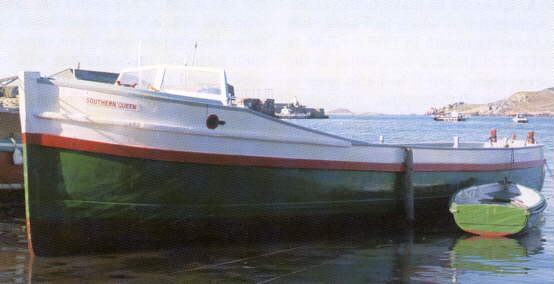

| Type | Passenger Motor Vessel |
| Length | 51ft |
| Beam | 12ft |
| Draft | 3ft 6ins |
| Displacement | 20 tons |
| Engine | Ford Barracuda Diesel |
| Construction | Oak |
| Builder | Short Bros., Rochester |
| Year Built | 1926 |
The Southern Queen is a robust open boat, 51ft long, with a 12ft beam and a displacement of 20 tons. Although she might roll a little with her 3ft 6in draught, her oak construction and copper fastenings made her sound and strong. Before the war, she worked out of Folkestone and at Dunkirk she was commanded by Sub-Lieut. B.G.P de Mattos. She would have been towed across by one of the tugs and must have been invaluable getting troops off the beach and taking them to the destroyers anchored off. After Dun-kirk, she remained in Naval service throughout the war. Once hostilities were over, she returned to carrying trippers out of Folkestone and gave a great deal of pleasure to holiday-makers at the seaside. Later, she was taken out to the beautiful Isles of Scilly, 30 miles west of Land's End, with their rugged scenery and balmy climate warmed by the Gulf Stream. There, since 1957 and with a crew of two, she took up to 81 passengers at a time on sightseeing trips to see the seals, the puffins and the spectacular scenery of the islands. Often she coped with 300 visitors a day.
In 1990, Basil de Mattos wrote the following letter to Alec Hicks, her owner at the time -
Dear Mr Hicks,
I was recently rather amazed to see the pictures and story of the Southern Queen in ‘The Little Ships of Dunkirk’.
I thought you might like to hear from a former ‘owner’, albeit for just three long days.
I refer to her trips to Dunkirk. She was never towed as the article suggests. She did runs to and fro in my care and towed the Eastbourne Lifeboat and a motor yacht called ‘Skylark’ all the way back on the final trip, finding them drifting outside Dunkirk.
Finally she towed a Dutch ‘Scoot’ through the entrance at Dover - her engines seized within half a mile of the entrance, she was full of soldiers.
I cannot remember how many trips into Dunkirk harbour we made. It was like a bus service the last night, we took off about 70 Frenchmen at a time from the eastern arm, all with their full equipment. I climbed up onto the wooden harbour wall, trod on someone’s fingers and found there were a few hundred chaps lying down! That’s how I realised we were under fire - they blew away the ladder I’d just climbed up!
I had a marvellous crew of three cadet ratings who manhandled weary and exhausted soldiers like they were sacks. We put them on bigger ships half a mile out.
When I arrived in Dover at midnight three days before, by coach from Hove where we were training a Naval Commander gave me a torch (I still have it in my car) and said “That’s yours, she seems to sink at full tide but they say ‘she goes OK’”
The exhaust pipe flange had been unbolted for some reason. We refitted it in the dark, making gaskets from a sheet of Hallite. The magneto and all electrics were in the care of the landlord of the Hotel de Paris nearby. We drained the engine, put in new oil, fitted the magneto, plugs etc. and believe it or not she fired at about the third pull. I doubt she has the same engine today?
We had no chart, no compass that I remember, but I feel we must have had one. The Commander said, “You know where Dunkirk is don’t you?” I said, “just east of Calais”, that’s all I knew. Then we were told to head for the smoke from the burning oil dumps. The wind was from the East for all the week, so the left-hand edge of the smoke was Dunkirk! The wonderful old boat never missed a beat all the time. We motored over each afternoon if I remember, worked all night as a taxi in and out of the harbour (not the Beaches at all), then came back in the early dawn and the morning. I don’t remember when we slept. Grub was by courtesy of the aforementioned landlord. I later discovered he was a German who had lived in Dover for many years!
I have not been in Scilly since a holiday about 1950 but was there frequently in 1941 in ML184, we were on detached duties and were based in Newlyn, but used St Mary’s and Appledore quite a lot. I was a friend of Capt. Roseigh (forgive spelling) of the Scillonian in the war years.
Well I hope the old lady is as good as ever and all good luck to you and her.
Yours most sincerely, (Signed) Basil de Mattos
In 1996 the national press reported that she was beached at St. Marys, Scilly Isles and was going to be burned. She had been there for two years and had been stripped and was unseaworthy. She was saved and in 1997, mainly through the efforts of Charles Cave (recent past Commodore of The ADLS) and his wife, after being made watertight, she was towed to Newlyn in Cornwall by the old Salcombe Lifeboat owned by Coxswain Frank Smith. Once at Newlyn she was lifted out and transported by road to Crowlas, Penzance for restoration. This started in June 1998, and now the restoration is nearly complete with many new ribs and much oak planking. Her owner, Philip Hammond took her back to Dunkirk on the 2000 return and is now the proud owner of a fully functional and capable craft.
She has now been sold.
Source: 1, 2, 3, 4, 5, 11, 19 & 20
Updated: 13/07/03